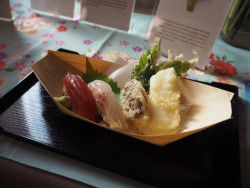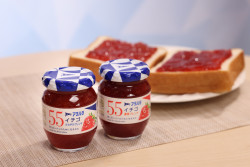
Originally published on metropolis.co.jp on June 2009

Photo Courtesy of Conrad Tokyo
For those who grew up in the West, where the approach to food and wine is rather more laissez-faire than it is in Japan, the notion of marrying Japanese cuisine with wine does not necessarily appear blasphemous. Rather, it sounds like good fun—and that is what wine, at least for me, is all about.
In Japan, however, rigidity is inherent in the ritualistic and highly aesthetic canon of good sushi. From the perspective of most Japanese, “taste” dictates sake or beer. It’s not that wine does not work, but rather that it is not “supposed to go” with sushi.
Nevertheless, us barbarians at the gate understand the fun of tinkering with social mores. Those who have marched to the beat of Grüner Veltliner with Vietnamese at the Slanted Door in San Francisco, or unoaked Semillon with Thai at Sydney’s Longrain, appreciate the spirit of adventure inherent in food and wine that is not necessarily built around any culinary rubric. After all, Japanese cuisine is subtler and less bold than its Southeast Asian brethren, and pairs with many wines.
The difficulties lie with the compartmentalized nature of the food—the ebbs and flows, if you will. It is difficult to pair any one wine with an array of small dishes and, in the case of sushi, a multitude of sea creatures on the same plate. What to do?
The Conrad Tokyo’s Kazahana restaurant recently held a lunch with a small but deft selection of sushi and wine, hosted by Master of Wine Ron Georgiou (left). In the presence of a number of journos from Japanese food mags, Georgiou was quick to point out that he was not endeavoring to find succinct harmonies. Rather, he proposed a selection of wines, and it was up to us to experiment freely.
The first course was a mound of mountain veggies with soy and katsuodashi, which is full of glutamates inherent to umami. Glutamates are stuffed full of protein acids that one finds in yeasty wines, particularly sparkling wines, including Champagne. Rule 1: similar traits pair well. For this reason, the smoky NV Perrier Jouet Rosé was the pick with this dish.
Next came the assortment of sushi: tuna, squid, flounder, horse mackerel, shrimp and an omelet that was so sweet and stodgy it reminded me of pound cake—definitely out of synch with the rest of the meal. While the Champagne worked nicely with all of the dishes, I lurched into a 2006 Pieropan Soave from Italy’s Veneto, a 2007 Katsunuma Jyozo Aruga Branca Koshu from Yamanashi, and a not-quite-sure-why-it-was-there Newton 2006 Chardonnay from Napa. The latter I immediately pushed aside due to an overwhelming aroma of confected tropical fruit and oak. In order to experiment with the wines, it was necessary to bite the sushi pieces in halves. Clearly this is not appropriate behavior, but journos and barbarians alike joined in joyously!
Verdict: the white wines synergized with the food if one garnished most of the sushi morsels with rock salt rather than dipping in soy sauce.
Why not soy? Shoyu is high in lactic acidity, which means that it pairs better with wines that have gone through malolactic fermentation. Most red wines have undergone this transformation, meaning reds generally synergize with soy better than whites. Given the nature of sushi, however, the game was for fresh, relatively subtle whites to synergize with minimalist flavors emphasizing the raw ingredient. Rule 2: similar weights, or bodies, pair well. In this case, light/mid-weight whites with subtle, fresh ingredients.
There are clearly types of sushi that work better with soy. With tuna and soy, Pinot Noir or Gamay go well—or perhaps, as Georgiou noted, a traditional soft Rioja. In the case of mackerel, even with the traditional accompaniment of ginger, soft sweet-fruited Grenache-based wines sing. Think Côtes du Rhône or unoaked styles from Navarra in Spain. While Grenache also flourishes in the New World, wines from the likes of Barossa or California are likely to bludgeon, rather than coax subtleties from sushi.
Soft Grenache styles also work well with sardines and other blue fish—think Mediterranean cultures. Grenache’s soft tannins mean the “fishy” iodine note, or the aluminum-can aftertaste, is not exacerbated, while the fleshy sweetness of the wine absorbs the oily, saline nature of the fish. Rules 3 & 4: differences also find parity and some reds do work with fish.
For the lunch, however, there were no reds. The broad, peachy and distinctly peppery Soave matched well with all of the sushi, as did the Koshu (aside from with the mackerel, for reasons explained above). The freshness of the wines made the fish too metallic.
The Soave’s pepperiness may have been intrusive for some, whereas conversely, the Koshu’s lightweight innocuousness proved to be its appeal with the delicate fare. While I would not drink this wine for pleasure, it epitomizes the Japanese notion of nomiyasui, or easy to drink, and is appealing in the context.
Rule 5: although not always true, regional harmonies find parity.
Kazahana. Conrad Tokyo, 28F, 1-9-1 Higashi-Shimbashi, Minato-ku. Tel: 03-6388-8000. Open Tue-Sat 11:30am-2pm and 5:30-9pm, Sun 11:30am-2pm, closed Mon. Nearest stn: Shimbashi or Shiodome. http://ConradHotels.com







